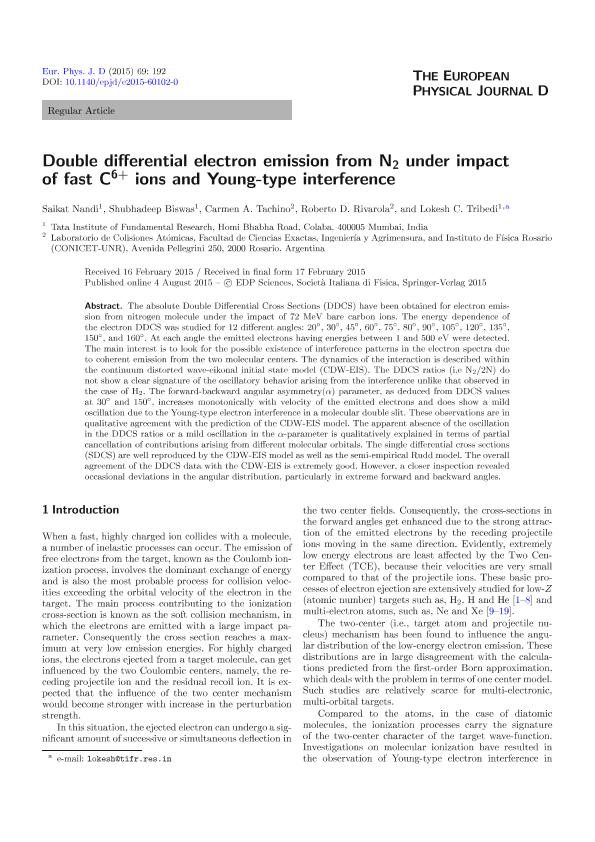Mostrar el registro sencillo del ítem
dc.contributor.author
Nandi, Saikat
dc.contributor.author
Biswas, Shubhadeep
dc.contributor.author
Tachino, Carmen Alejandra

dc.contributor.author
Rivarola, Roberto Daniel

dc.contributor.author
Tribedi, Lokesh C.
dc.date.available
2016-06-10T18:36:21Z
dc.date.issued
2015-07
dc.identifier.citation
Nandi, Saikat; Biswas, Shubhadeep; Tachino, Carmen Alejandra; Rivarola, Roberto Daniel; Tribedi, Lokesh C.; Double differential electron emission from N2 under impact of fast C6+ ions and Young-type interference; Springer; European Physical Journal D; 69; 7-2015; 192-192
dc.identifier.issn
1434-6060
dc.identifier.uri
http://hdl.handle.net/11336/6158
dc.description.abstract
The absolute Double Differential Cross Sections (DDCS) have been obtained for electron emission from nitrogen molecule under the impact of 72 MeV bare carbon ions. The energy dependence of the electron DDCS was studied for 12 different angles: 20°, 30°, 45°, 60°, 75°, 80°, 90°, 105°, 120°, 135°, 150°, and 160°. At each angle the emitted electrons having energies between 1 and 500 eV were detected. The main interest is to look for the possible existence of interference patterns in the electron spectra due to coherent emission from the two molecular centers. The dynamics of the interaction is described within the continuum distorted wave-eikonal initial state model (CDW-EIS). The DDCS ratios (i.e N2/2N) do not show a clear signature of the oscillatory behavior arising from the interference unlike that observed in the case of H2. The forward-backward angular asymmetry(α) parameter, as deduced from DDCS values at 30° and 150°, increases monotonically with velocity of the emitted electrons and does show a mild oscillation due to the Young-type electron interference in a molecular double slit. These observations are in qualitative agreement with the prediction of the CDW-EIS model. The apparent absence of the oscillation in the DDCS ratios or a mild oscillation in the α-parameter is qualitatively explained in terms of partial cancellation of contributions arising from different molecular orbitals. The single differential cross sections (SDCS) are well reproduced by the CDW-EIS model as well as the semi-empirical Rudd model. The overall agreement of the DDCS data with the CDW-EIS is extremely good. However, a closer inspection revealed occasional deviations in the angular distribution, particularly in extreme forward and backward angles.
dc.format
application/pdf
dc.language.iso
eng
dc.publisher
Springer

dc.rights
info:eu-repo/semantics/openAccess
dc.rights.uri
https://creativecommons.org/licenses/by-nc-sa/2.5/ar/
dc.subject
Molecular Ionization
dc.subject
Interference Effects
dc.subject
Distorted Wave Models
dc.subject.classification
Física Atómica, Molecular y Química

dc.subject.classification
Ciencias Físicas

dc.subject.classification
CIENCIAS NATURALES Y EXACTAS

dc.title
Double differential electron emission from N2 under impact of fast C6+ ions and Young-type interference
dc.type
info:eu-repo/semantics/article
dc.type
info:ar-repo/semantics/artículo
dc.type
info:eu-repo/semantics/publishedVersion
dc.date.updated
2016-06-01T13:48:27Z
dc.journal.volume
69
dc.journal.pagination
192-192
dc.journal.pais
Alemania

dc.journal.ciudad
Berlin
dc.description.fil
Fil: Nandi, Saikat. International Centre Of Theoretical Science. Tata Institute Of Fundamental Research; España
dc.description.fil
Fil: Biswas, Shubhadeep. International Centre Of Theoretical Science. Tata Institute Of Fundamental Research; España
dc.description.fil
Fil: Tachino, Carmen Alejandra. Consejo Nacional de Investigaciones Científicas y Técnicas. Centro Científico Tecnológico Rosario. Instituto de Física de Rosario (i); Argentina
dc.description.fil
Fil: Rivarola, Roberto Daniel. Consejo Nacional de Investigaciones Científicas y Técnicas. Centro Científico Tecnológico Rosario. Instituto de Física de Rosario (i); Argentina
dc.description.fil
Fil: Tribedi, Lokesh C.. International Centre Of Theoretical Science. Tata Institute Of Fundamental Research; España
dc.journal.title
European Physical Journal D

dc.relation.alternativeid
info:eu-repo/semantics/altIdentifier/url/http://link.springer.com/article/10.1140%2Fepjd%2Fe2015-60102-0
dc.relation.alternativeid
info:eu-repo/semantics/altIdentifier/doi/10.1140/epjd/e2015-60102-0
dc.relation.alternativeid
info:eu-repo/semantics/altIdentifier/doi/http://dx.doi.org/10.1140/epjd/e2015-60102-0
Archivos asociados
